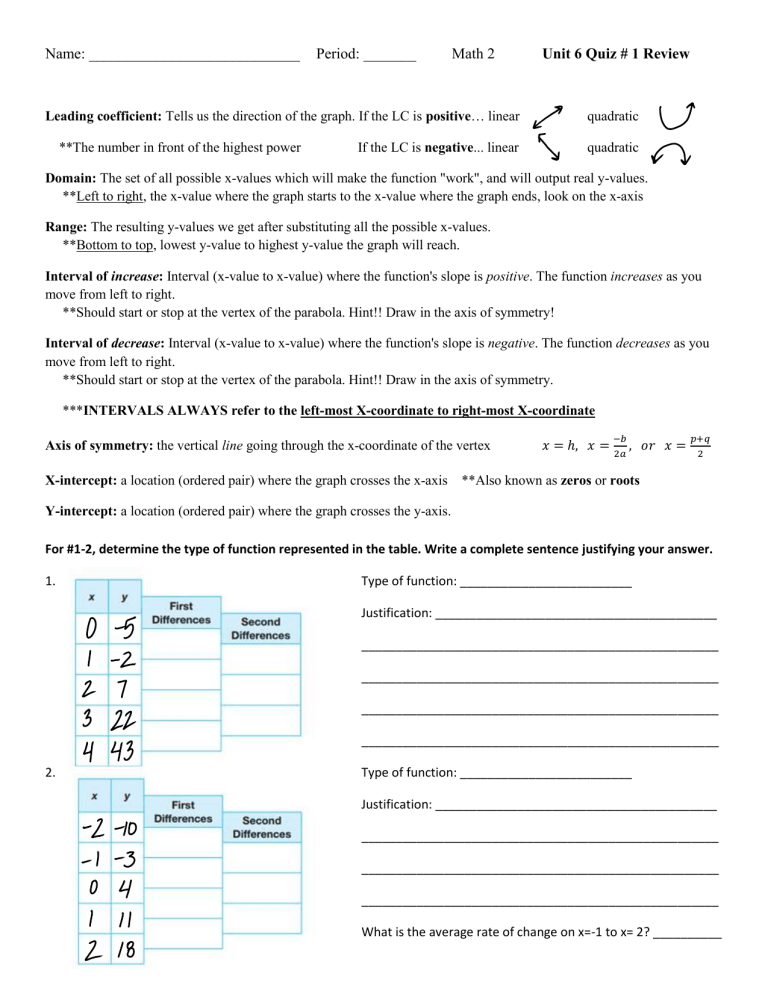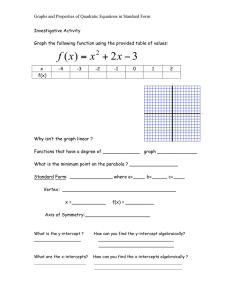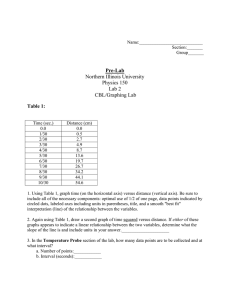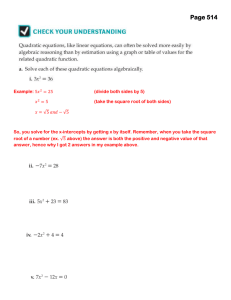Quadratics Math 2 Quiz review
advertisement

Name: ____________________________ Period: _______ Math 2 Leading coefficient: Tells us the direction of the graph. If the LC is positive… linear **The number in front of the highest power If the LC is negative... linear Unit 6 Quiz # 1 Review quadratic quadratic Domain: The set of all possible x-values which will make the function "work", and will output real y-values. **Left to right, the x-value where the graph starts to the x-value where the graph ends, look on the x-axis Range: The resulting y-values we get after substituting all the possible x-values. **Bottom to top, lowest y-value to highest y-value the graph will reach. Interval of increase: Interval (x-value to x-value) where the function's slope is positive. The function increases as you move from left to right. **Should start or stop at the vertex of the parabola. Hint!! Draw in the axis of symmetry! Interval of decrease: Interval (x-value to x-value) where the function's slope is negative. The function decreases as you move from left to right. **Should start or stop at the vertex of the parabola. Hint!! Draw in the axis of symmetry. ***INTERVALS ALWAYS refer to the left-most X-coordinate to right-most X-coordinate Axis of symmetry: the vertical line going through the x-coordinate of the vertex 𝑥 = ℎ, 𝑥 = −𝑏 , 2𝑎 𝑜𝑟 𝑥 = 𝑝+𝑞 2 X-intercept: a location (ordered pair) where the graph crosses the x-axis **Also known as zeros or roots Y-intercept: a location (ordered pair) where the graph crosses the y-axis. For #1-2, determine the type of function represented in the table. Write a complete sentence justifying your answer. 1. Type of function: _________________________ Justification: _________________________________________ ____________________________________________________ ____________________________________________________ ____________________________________________________ ____________________________________________________ 2. Type of function: _________________________ Justification: _________________________________________ ____________________________________________________ ____________________________________________________ ____________________________________________________ What is the average rate of change on x=-1 to x= 2? __________ 3. Tell me everything you know about the function 𝑓(𝑥) = −8𝑥 + 2 based on the equation. Be as specific as possible. __________________________________________________________________________________________________ __________________________________________________________________________________________________ For #4-6, determine the type of function represented by the graph or equation. State whether the leading coefficient is positive or negative. 4. 5. 𝑓(𝑥) = 2𝑥 2 − 3𝑥 + 4 6. Type: ______________________ LC: _______________________ What does this tell you about what the graph will look like? Type: _____________________ Type: _____________________ LC: _____________________ LC: _____________________ For #12 – 13, identify the rquested information. 7. Vertex: x-intercepts: Domain: Interval of increase: Axis of symmetry: Max/Min: y-intercept: Range: Interval of Decrease: 8. Vertex: x-intercepts: Domain: Interval of increase: Axis of symmetry: Max/Min: y-intercept: Range: Interval of Decrease: 9. A mini marshmallow is catapulted from the ground. It’s path of flight can be modeled by the function ℎ(𝑡) = −2𝑡 2 + 10𝑡, where h(t) is the height of the marshmallow in feet and t is the time in seconds. The graph of the function is shown below. a. What is the domain and range of this problem in context? b. What is the domain and range of the function? c. Over what interval in the context of the problem is the height increasing? Decreasing? d. After approximately how many seconds is the marshmallow at a height of 8 feet? e. What is the height of the marshmallow after 3 seconds? f. What is the maximum height the marshmallow will reach? How many seconds have gone by when the marshmallow reaches its maximum height? g. Determine the x-intercepts of the function. What do they mean in terms of the problem situation? 10. A rock is thrown with an initial velocity of 50 ft/sec from the top of a 1000 foot skyscraper. How long does it take for the rock to hit the street below?




